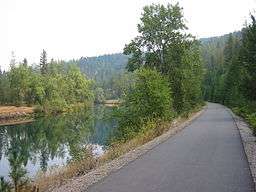Trail of the Coeur d'Alenes
| Trail of the Coeur d'Alenes | |
|---|---|
|
Trail of the Coeur d'Alenes as it follows the Coeur d'Alene River 47°30′35″N 116°32′13″W / 47.50972°N 116.53694°WCoordinates: 47°30′35″N 116°32′13″W / 47.50972°N 116.53694°W | |
| Length | 73 mi (117 km) |
| Location | Idaho Panhandle |
| Trailheads |
Mullan, Idaho Plummer, Idaho |
| Use | Biking, in-line skating, hiking |
| Hiking details | |
| Trail difficulty | Easy |
| Season | Year-round |
| Sights | Silver Valley, Lake Coeur d'Alene, Heyburn State Park, Palouse |
| Website |
parksandrecreation |
The Trail of the Coeur d'Alenes is a rail trail in Idaho, USA, which follows the former Union Pacific Railroad right-of-way from Mullan, a mountain mining town near the Montana border, to Plummer, a town on the prairie near the Washington border.
The trail's 73-mile (117 km) route winds through the mountainous terrain of the historic Silver Valley, into the chain lakes region, along the shore of Lake Coeur d'Alene, over the Chatcolet Bridge to Heyburn State Park, and finally climbs to the Palouse prairie. Trail users can continue along a bike path in Washington that will eventually lead to Spokane.
The Trail of the Coeur d'Alenes includes camping facilities and rest areas regularly. The trail leads through protected marsh lands, offering the cyclist a glimpse of eagle and osprey nests, moose, elk, and a variety of ducks and other wildlife, as well as some rare species of wildflowers and accompanying butterflies as a result of the age-old soot from the old railroad.
The trail is not only a recreational facility, but also a solution to environmental problems left behind by Idaho's mining industry. Silver, lead and zinc were discovered in the valley around 1884, and a rail line was built to access the mines around 1888. Much of the rock in the railbed was either waste rock from mines, or tailings containing heavy metals. The railbed was also contaminated with spillage from passing trains. To remedy these environmental problems, the Union Pacific Railroad, U.S. Government, the State of Idaho, and the Coeur d'Alene Tribe partnered to build a trail. The thick asphalt and the gravel barriers on the sides of the trail serve as a permanent cap to isolate contaminants from the surrounding environment.
